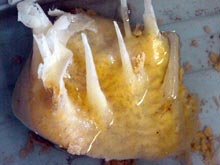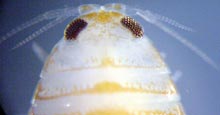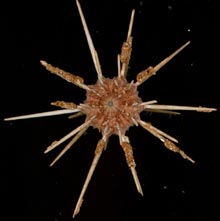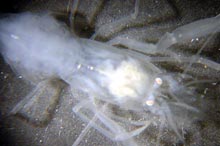
Scientists hope this "chimney" sponge collected more than 1,250 ft below the sea surface may reveal symbioses not previously witnessed. Click image for larger view.
Symbioses in the Sea
August 15, 2003
Susan Thornton-DeVictor
Southeastern Regional Taxonomic Center
South Carolina Department of Natural Resources
Symbiotic relationships are a very important component of life in the ocean. In such relationships, plants or animals of different species may be dependent on one another for survival. They may share habitats or lifestyles, or interact in a specific way to benefit from the presence of another organism. When two organisms are in a symbiotic relationship, sometimes both organisms benefit (mutualism), other times one organism may benefit while another is unaffected (commensalism). If one of the organisms is completely dependent on the other, it is called an obligate relationship; if the relationship is preferred, but not dependent, it is a facultative relationship. Although there are many ways organisms interact with one another, most symbioses involve clever ways to obtain food or protection.
One of the most famous symbiotic interactions, the relationship between coral and algae (called zooxanthellae), was briefly discussed in the August 6 Log.
Crustaceans (e.g., shrimps, lobsters, crabs, amphipods) are often involved in symbiotic relationships. In its juvenile stage, the spider crab can be seen hitching a ride inside the bell of the cannonball jellyfish. In what is thought to be a cleaning association, the Columbus crab hangs onto the backside of the loggerhead sea turtle during the years the turtle is living a pelagic life in the sargassum. Species of snapping shrimp and gobies inhabit the same burrow; since the shrimp is blind, the goby warns it of unwanted company, while the shrimp keeps the burrow clean. Small amphipods live deep in the pockets of sponges, which contain many protective spaces, while the sponge may benefit from food particles left over from the amphipods. Hermit crabs are often found inhabiting shells decorated with anemones or other sessile animals, which offer added protection and camouflage. Many species of shrimp and small juvenile fish clean larger fish of parasites by picking in their gills and mouths. The large fish stop at these “cleaning stations” periodically, as if they are pulling in for an oil change. The cleaners get an easy meal and the cleaned fish are freed of pests.

This parasitic crustacean (isopod) sometimes attaches to the foreheads of fish. Click image for larger view.
Not all symbioses are positive for both organisms. In a parasitic relationship, one member benefits while the “host” is harmed. Certain groups of barnacles and isopods may crawl under the carapaces of crabs and attach, sometimes rendering the crab sterile or unable to molt its exoskeleton. Often, crustaceans that are closely related to the pill bugs we see on land are found attached to the foreheads of fish. If for no other reason, the fish may suffer from a case of embarrassment!
Deep-sea symbioses are understood and documented to a lesser degree than those frequently encountered in shallower habitats. Although not always visually apparent, bacteria may play a large role in deep-water symbioses. While most primary production is accomplished by photosynthesis in plant species living in habitats with plenty of sunlight, most deep-water habitats have insufficient light.
Bacteria are responsible for bioluminescence in some deep-sea animals. On land, you have probably seen fireflies flashing on a warm summer’s night. Similar processes also occur in the ocean. Some fishes and squids bioluminesce to attract mates or find food in the darkness. While some animals can light themselves up, others rely on the bacteria housed in their cells for help. A glowing, bacterially powered “lure” from an anglerfish will attract a tasty meal in the darkness of the deep sea, for example.
Associations observed on this cruise
On this cruise, we have observed some associations involving epibionts, which are animals living on other animals. The pencil sea urchin pictured below (left) has worm tubes on the undersides of its spines. This is most likely a commensal relationship, since the tubeworm has a protected place to attach but is exposed to high water flow. It is not known why they attach to the undersides of the spines, or if the urchin is affected in any way.
We collected a galatheid crab, or “squat lobster," with barnacles attached to its carapace. Since the barnacles are attached to “substrate” that the crab will discard during its next molt, the effects of the barnacle attachment on the crab are temporary. Perhaps the life cycle of the barnacle is dependent on the molt cycle of the crab.

A pencil urchin collected at 1,750 ft depth has tubeworms attached to its spines. The view is from the under or “oral” side. Click image for larger view.

This tiny shrimp appears to be specially adapted to mimic the translucent color of the glass sponge it inhabits. Click image for larger view.
Scientists collected a beautiful translucent glass sponge with the sub’s scoop sampler. After taking a closer look at it back at the surface, they also found a clear shrimp hiding inside. The relationship between the sponge and the shrimp is unknown.
Upon closer examination of the collections, we hope to find some new biological symbioses or associations, especially with the deep-water corals and sponges. These organisms often provide structural complexity in areas that are otherwise devoid of habitat. There may very well be organisms, such as shrimps or crabs, that depend on corals or sponges for their survival.
























